Approach to Pyrido[2,1-b][1,3]benzothiazol-1-ones via In Situ Generation of Acyl(1,3-benzothiazol-2-yl)ketenes by Thermolysis of Pyrrolo[2,1-c][1,4]benzothiazine-1,2,4-triones
Abstract
:1. Introduction
2. Results and Discussion
3. Materials and Methods
3.1. General Information
General Procedure for Compounds 2a–g
- 2-(1,3-Benzothiazol-2-yl)-4-benzoyl-1-oxo-1H-pyrido [2,1-b][1,3]benzothiazol-3-yl benzoate (2a). Yield: 71 mg (85%); yellow solid; mp 299–301 °C. 1H NMR (400 MHz, CDCl3): δ = 9.51 (m, 1 H), 7.90 (m, 2 H), 7.68–7.48 (m, 8 H), 7.37–7.13 (m, 6 H), 7.00 (m, 1 H) ppm. 13C NMR (100 MHz, CDCl3): δ = 191.8, 163.6, 161.2, 158.3, 156.0, 155.2, 152.0, 140.4, 137.5, 135.4, 133.2, 131.1, 130.3 (2C), 129.1, 128.8, 128.2 (2C), 127.8 (2C), 127.8, 127.7 (2C), 127.6, 125.6, 124.8, 122.4, 121.9, 121.0 (2C), 108.7, 108.6 ppm. IR (mineral oil): 1742, 1657 cm−1. Anal. Calcd (%) for 3C32H18N2O4S2 · C7H7: C 69.97; H 3.53; N 4.75. Found: C 69.68; H 3.43; N 5.18. The crystal structure of compound 2a was deposited at the Cambridge Crystallographic Data Centre with the deposition number CCDC 2277018. Crystal Data: C32H18N2O4S2, M = 558.60, triclinic, a = 7.2896(13) Å, b = 16.634(3) Å, c = 21.579(2) Å, α = 80.604(11)°, β = 88.828(11)°, γ = 85.776(14)°, V = 2574.4(7) Å3, T = 295(2), space group P–1, Z = 2, μ(MoKα) = 0.251 mm−1. The final refinement parameters: R1 = 0.0842 [for observed 5887 reflections with I > 2σ(I)], wR2 = 0.2491 (for all independent 12279 reflections, Rint = 0.0619), S = 1.059. Largest diff. peak and hole, 0.434 and −0.531 ēÅ−3.
- 2-(1,3-Benzothiazol-2-yl)-4-(4-methylbenzoyl)-1-oxo-1H-pyrido [2,1-b][1,3]benzothiazol-3-yl 4-methylbenzoate (2b). Yield: 88 mg (89%); yellow solid; mp 311–313 °C. 1H NMR (400 MHz, CDCl3): δ = 9.51 (m, 1 H), 8.04–7.85 (m, 3 H), 7.72–7.44 (m, 7 H), 7.34–7.01 (m, 5 H), 2.44 (s, 3 H), 2.17 (s, 3 H) ppm. 13C NMR (125 MHz, CDCl3): δ = 191.7, 163.6, 161.2, 158.4, 156.0, 155.0, 152.0, 143.9, 141.9, 137.4, 135.3, 130.4 (2C), 129.0, 128.8 (2C), 128.7, 128.4 (2C), 128.0 (2C), 127.7, 127.5, 126.2, 125.5, 125.3, 124.7, 122.5, 121.9, 121.0, 120.9, 108.8, 21.8, 21.3 ppm. IR (mineral oil): 1742, 1654 cm−1. Anal. Calcd (%) for C34H22N2O4S2: C 69.61; H 3.78; N 4.78. Found: C 70.00; H 3.73; N 4.64.
- 2-(1,3-Benzothiazol-2-yl)-4-(4-chlorobenzoyl)-1-oxo-1H-pyrido [2,1-b][1,3]benzothiazol-3-yl 4-chlorobenzoate (2c). Yield: 94 mg (81%); yellow solid; mp 312–314 °C. 1H NMR (400 MHz, CDCl3): δ = 9.51 (m, 1 H), 8.07 (m, 2 H), 7.92 (m, 2 H), 7.73–7.08 (m, 11 H) ppm. 13C ssNMR (100 MHz): δ = 191.6, 161.8, 159.5, 153.7, 150.1, 138.3, 136.5, 132.8, 129.5, 126.2, 122.5, 118.6, 110.5 ppm. IR (mineral oil): 1751, 1663 cm−1. Anal. Calcd (%) for C32H16Cl2N2O4S2: C 61.25; H 2.57; N 4.46. Found: C 61.39; H 2.63; N 4.29.
- 2-(1,3-Benzothiazol-2-yl)-4-(4-bromobenzoyl)-1-oxo-1H-pyrido [2,1-b][1,3]benzothiazol-3-yl 4-bromobenzoate (2d). Yield: 97 mg (91%); yellow solid; mp 318–320 °C. 1H NMR (400 MHz, CDCl3): δ = 9.51 (m, 1 H), 8.00–7.89 (m, 4 H), 7.79–7.30 (m, 10 H), 7.12 (m, 1 H) ppm. 13C ssNMR (100 MHz): δ = 191.6, 162.1, 159.5, 154.4, 150.2, 138.7, 136.6, 132.8, 129.7, 126.3, 122.8, 121.0, 118.7, 110.5, 107.2 ppm. IR (mineral oil): 1752, 1665 cm−1. Anal. Calcd (%) for C32H16Br2N2O4S2: C 53.65; H 2.25; N 3.91. Found: C 53.31; H 2.08; N 3.77.
- 2-(1,3-Benzothiazol-2-yl)-4-(4-fluorobenzoyl)-1-oxo-1H-pyrido [2,1-b][1,3]benzothiazol-3-yl 4-fluorobenzoate (2e). Yield: 65 mg (73%); yellow solid; mp 283–285 °C. 1H NMR (400 MHz, DMSO-d6): δ = 9.35 (m, 1 H), 8.30 (m, 1 H), 8.11 (m, 1 H), 7.82–7.67 (m, 5 H), 7.61–7.43 (m, 1 H), 7.39–7.28 (m, 4 H), 7.19–7.12 (m, 2 H), 6.96 (m, 1 H) ppm. 13C NMR (125 MHz, CDCl3): δ = 190.2, 167.0, 165.5, 165.0, 163.5, 162.5, 161.0, 158.1, 155.5, 155.3, 151.9, 137.3, 136.4, 136.4, 135.2, 132.9, 132.8, 130.4, 130.3, 128.6, 127.9, 127.7, 125.7, 125.1, 125.1, 124.9, 122.3, 122.0, 121.0, 120.9, 115.4, 115.4, 115.2, 115.2, 108.5, 108.3 ppm. 19F NMR (376 MHz, DMSO-d6): δ = -107.18, -110.75 ppm. IR (mineral oil): 1747, 1661 cm−1. Anal. Calcd (%) for C32H16F2N2O4S2: C 64.64; H 2.71; N 4.71. Found: C 64.52; H 2.73; N 4.65.
- 2-(1,3-Benzothiazol-2-yl)-4-(furan-2-carbonyl)-1-oxo-1H-pyrido [2,1-b][1,3]benzothiazol-3-yl furan-2-carboxylate (2f). Yield: 47 mg (58%); yellow solid; mp 272–274 °C. 1H NMR (400 MHz, DMSO-d6): δ = 9.31 (m, 1 H), 8.23 (m, 1 H), 8.13 (m, 1 H), 8.08 (m, 1 H), 8.01 (m, 1 H), 7.77–7.69 (m, 2 H), 7.51 (m, 1 H), 7.40 (m, 2 H), 7.34 (m, 1 H), 7.13 (m, 1 H), 6.81 (m, 1 H), 6.69 (m, 1 H) ppm. 13C NMR (125 MHz, CDCl3): δ = 177.5, 160.9, 154.8, 154.5, 154.0, 152.2, 151.9, 147.0, 146.8, 144.3, 137.5, 136.5, 135.3, 128.1, 127.8, 127.6, 125.7, 125.0, 124.9, 122.4, 121.8, 121.1, 120.9, 119.6, 119.3, 112.2, 112.2, 108.4 ppm. IR (mineral oil): 1756, 1660 cm−1. Anal. Calcd (%) for C28H14N2O6S2: C 62.45; H 2.62; N 5.20. Found: C 62.59; H 2.43; N 5.28. The crystal structure of compound 2f was deposited at the Cambridge Crystallographic Data Centre with the deposition number CCDC 2277017. Crystal Data: 2(C28H14N2O6S2)∙C7H8, M = 1169.20, triclinic, a = 9.4943(16) Å, b = 12.3983(17) Å, c = 12.9210(16) Å, α = 111.584(13)°, β = 92.997(14)°, γ = 107.840(15)°, V = 1322.7(4) Å3, T = 295(2), space group P–1, Z = 1, μ(MoKα) = 0.253 mm−1. The final refinement parameters: R1 = 0.0579 [for observed 3726 reflections with I > 2σ(I)], wR2 = 0.1505 (for all independent 6240 reflections, Rint = 0.0481), S = 1.035. Largest diff. peak and hole, 0.234 and −0.274 ēÅ−3.
- 2-(1,3-Benzothiazol-2-yl)-4-(thiophene-2-carbonyl)-1-oxo-1H-pyrido [2,1-b][1,3]benzothiazol-3-yl thiophene-2-carboxylate (2g). Yield: 60 mg (70%); yellow solid; mp 278–280 °C. 1H NMR (400 MHz, DMSO-d6): δ = 9.33 (m, 1 H), 8.22 (m, 1 H), 8.12 (m, 1 H), 8.06 (m, 1 H), 8.00 (m, 1 H), 7.92 (m, 1 H), 7.78–7.69 (m, 3 H), 7.40–7.33 (m, 2 H), 7.25 (m, 1 H), 7.20 (m, 1 H), 7.05 (m, 1 H) ppm. 13C NMR (125 MHz, CDCl3): δ = 182.6, 160.9, 158.7, 158.2, 154.2, 154.1, 152.0, 143.1, 137.6, 135.3, 135.0, 134.1, 133.8, 133.7, 132.5, 128.1, 127.8, 127.7, 127.6, 127.5, 125.7, 124.8, 122.4, 121.8, 121.0, 121.0, 109.2, 108.8 ppm. IR (mineral oil): 1735, 1655 cm−1. Anal. Calcd (%) for C28H14N2O4S4: C 58.93; H 2.47; N 4.91. Found: C 58.67; H 2.04; N 4.82.
3.2. Computational Details
4. Conclusions
Supplementary Materials
Author Contributions
Funding
Institutional Review Board Statement
Informed Consent Statement
Data Availability Statement
Acknowledgments
Conflicts of Interest
Sample Availability
References
- Cannalire, R.; Chan, K.W.K.; Burali, M.S.; Gwee, C.P.; Wang, S.; Astolfi, A.; Massari, S.; Sabatini, S.; Tabarrini, O.; Mastrangelo, E.; et al. Pyridobenzothiazolones Exert Potent Anti-Dengue Activity by Hampering Multiple Functions of NS5 Polymerase. ACS Med. Chem. Lett. 2020, 11, 773–782. [Google Scholar] [CrossRef] [PubMed]
- Cannalire, R.; Tarantino, D.; Piorkowski, G.; Carletti, T.; Massari, S.; Felicetti, T.; Barreca, M.L.; Sabatini, S.; Tabarrini, O.; Marcello, A.; et al. Broad spectrum anti-flavivirus pyridobenzothiazolones leading to less infective virions. Antivir. Res. 2019, 167, 6–12. [Google Scholar] [CrossRef]
- Tarantino, D.; Cannalire, R.; Mastrangelo, E.; Croci, R.; Querat, G.; Barreca, M.L.; Bolognesi, M.; Manfroni, G.; Cecchetti, V.; Milani, M. Targeting flavivirus RNA dependent RNA polymerase through a pyridobenzothiazole inhibitor. Antivir. Res. 2016, 134, 226–235. [Google Scholar] [CrossRef] [Green Version]
- Manfroni, G.; Meschini, F.; Barreca, M.L.; Leyssen, P.; Samuele, A.; Iraci, N.; Sabatini, S.; Massari, S.; Maga, G.; Neyts, J.; et al. Pyridobenzothiazole derivatives as new chemotype targeting the HCV NS5B polymerase. Bioorg. Med. Chem. 2012, 20, 866–876. [Google Scholar] [CrossRef] [PubMed]
- Shigeta, S.; Hosoya, M.; Mochizuki, S.; Chiba, T. Studies on Antiviral Agents. I. Antiviral Activity of Pyridobenzoazoles. Yakugaku Zasshi 1988, 108, 856–859. [Google Scholar] [CrossRef] [PubMed] [Green Version]
- Fadda, A.A.; Soliman, N.N.; Bayoumy, N.M. Antimicrobial Properties of Some New Synthesized Benzothiazole Linked Carboxamide, Acetohydrazide, and Sulfonamide Systems. J. Heterocycl. Chem. 2019, 56, 2369–2378. [Google Scholar] [CrossRef]
- Youssef, A.M.; Malki, A.; Badr, M.H.; Elbayaa, R.Y.; Sultan, A.S. Synthesis and Anticancer Activity of Novel Benzimidazole and Benzothiazole Derivatives against HepG2 Liver Cancer Cells. Med. Chem. 2012, 8, 151–162. [Google Scholar] [CrossRef] [PubMed]
- Youssef, A.M.; Noaman, E. Synthesis and Evaluation of Some Novel Benzothiazole Derivatives as Potential Anticancer and Antimicrobial Agents. Arzneimittelforschung 2007, 57, 547–553. [Google Scholar] [CrossRef] [PubMed]
- Lystsova, E.A.; Khramtsova, E.E.; Maslivets, A.N. Acyl(imidoyl)ketenes: Reactive Bidentate Oxa/Aza-Dienes for Organic Synthesis. Symmetry 2021, 13, 1509. [Google Scholar] [CrossRef]
- Khramtsova, E.E.; Lystsova, E.A.; Dmitriev, M.V.; Maslivets, A.N.; Jasiński, R. Reaction of Aroylpyrrolobenzothiazinetriones with Electron-Rich Dienophiles. ChemistrySelect 2021, 6, 6295–6301. [Google Scholar] [CrossRef]
- Lystsova, E.A.; Dmitriev, M.V.; Maslivets, A.N.; Khramtsova, E.E. Nucleophile-induced ring contraction in pyrrolo[2,1-c][1,4]benzothiazines: Access to pyrrolo[2,1-b][1,3]benzothiazoles. Beilstein J. Org. Chem. 2023, 19, 646–657. [Google Scholar] [CrossRef] [PubMed]
- CrysAlisPro, Version 1.171.37.33 (release 27-03-2014 CrysAlis171.NET); Agilent Technologies: Santa Clara, CA, USA, 2014.
- Dolomanov, O.V.; Bourhis, L.J.; Gildea, R.J.; Howard, J.A.K.; Puschmann, H. OLEX2: A complete structure solution, refinement and analysis program. J. Appl. Cryst. 2009, 42, 339–341. [Google Scholar] [CrossRef]
- Sheldrick, G.M. A short history of SHELX. Acta Crystallogr. Sect. A Found. Crystallogr. 2008, 64, 112. [Google Scholar] [CrossRef] [PubMed] [Green Version]
- Sheldrick, G.M. Crystal structure refinement with SHELXL. Acta Crystallogr. Sect. C Struct. Chem. 2015, 71, 3–8. [Google Scholar] [CrossRef] [PubMed] [Green Version]
- MultiChrom for Windows (© 1993-2015 Ampersand Ltd.), Version 3.4.01468; Ampersand Ltd.: Moscow, Russia, 2015.
- Frisch, M.J.; Trucks, G.W.; Schlegel, H.B.; Scuseria, G.E.; Robb, M.A.; Cheeseman, J.R.; Scalmani, G.; Barone, V.; Mennucci, B.; Petersson, G.A.; et al. Gaussian 09, Revision, C.01; Gaussian, Inc.: Wallingford, CT, USA, 2010. [Google Scholar]
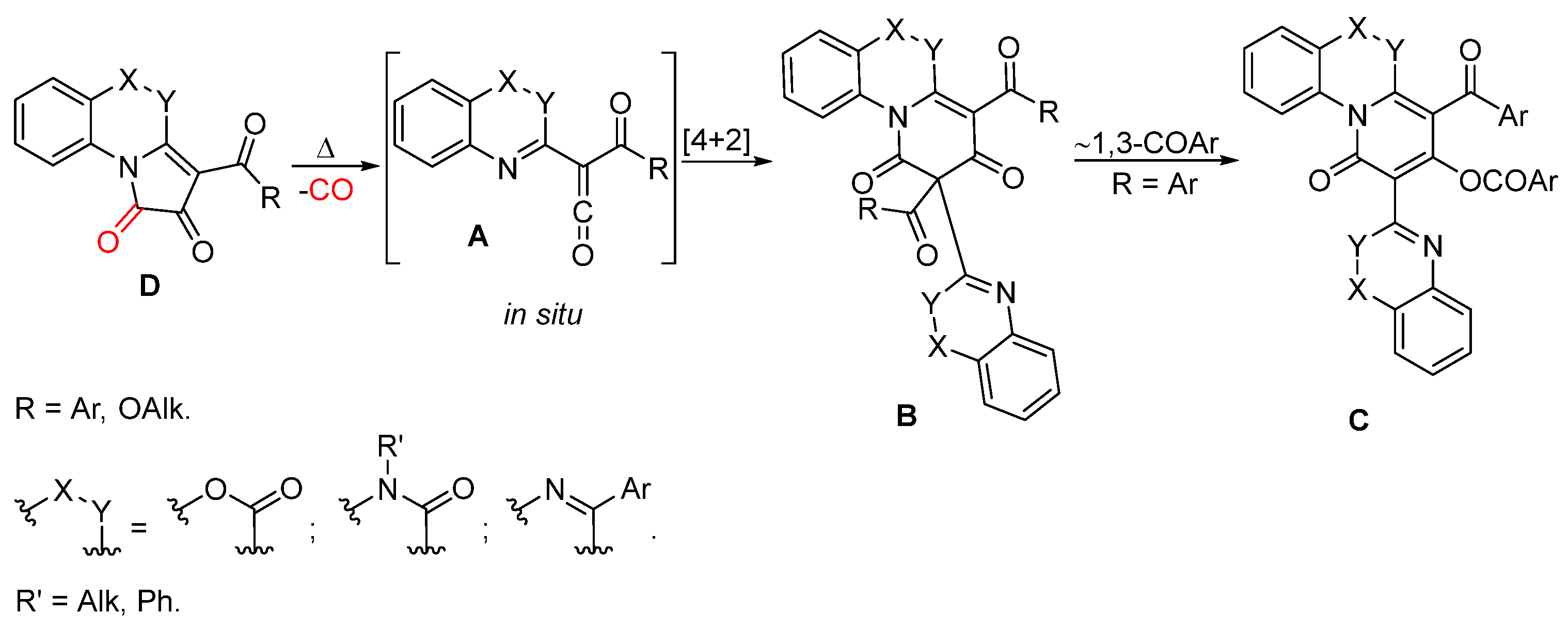

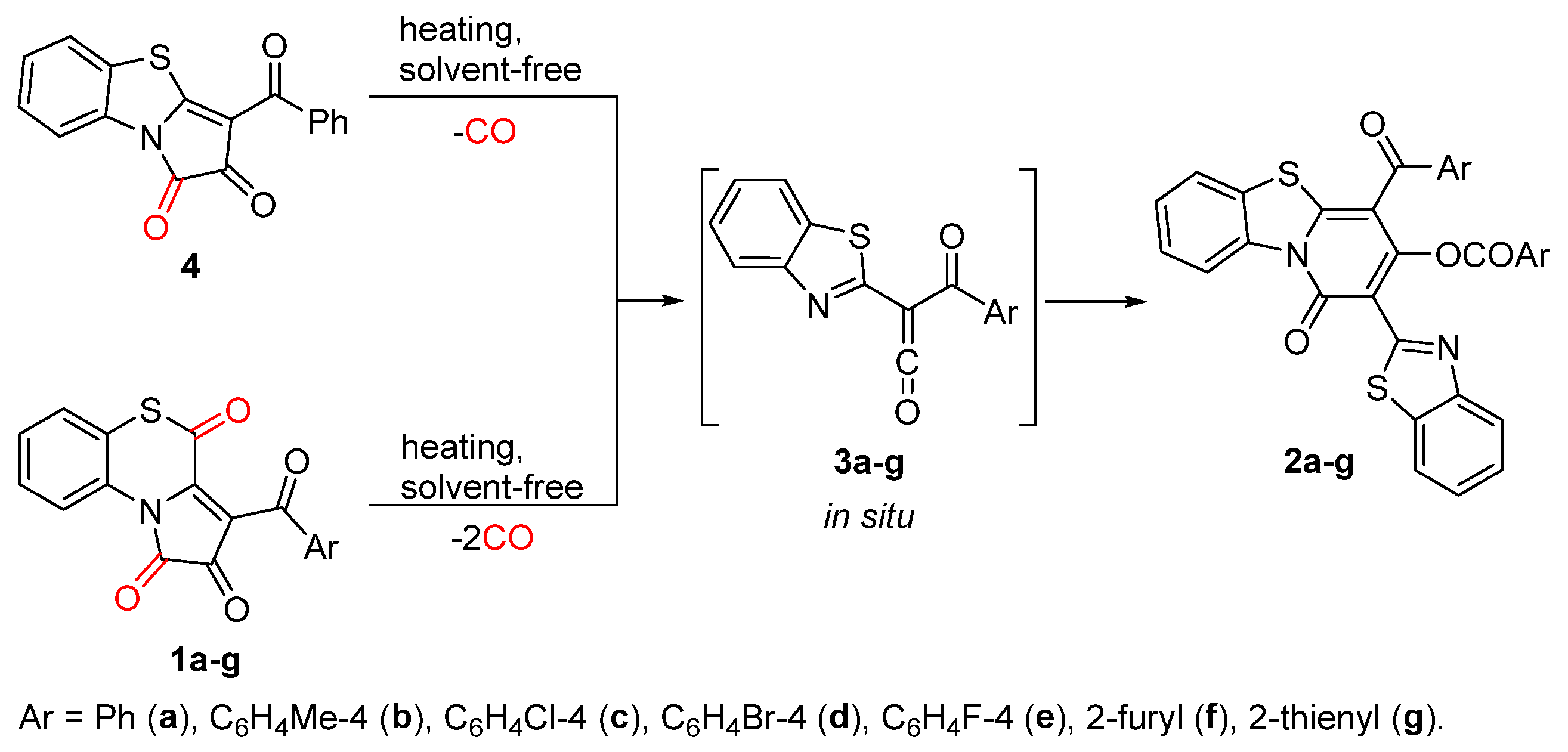
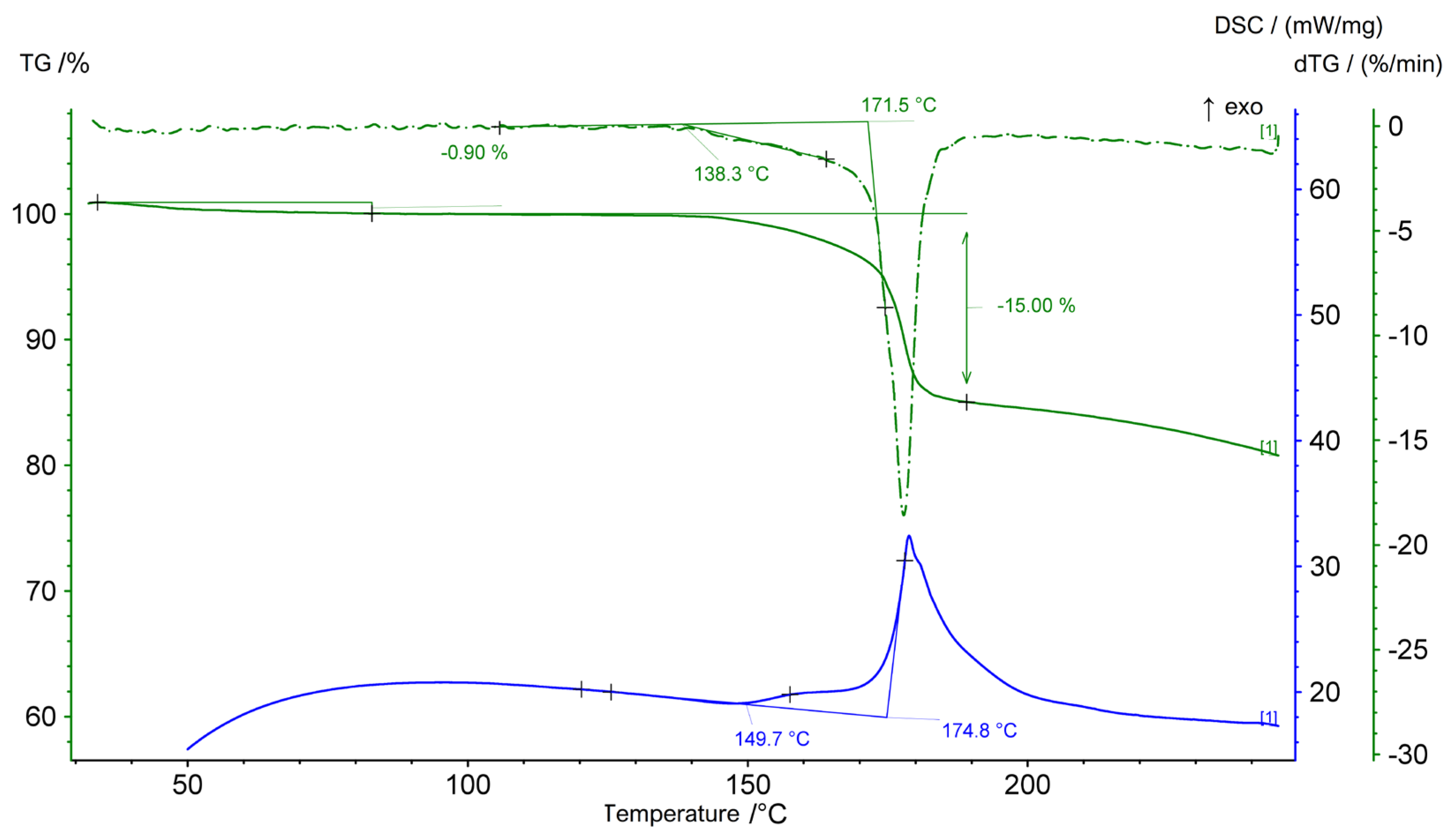
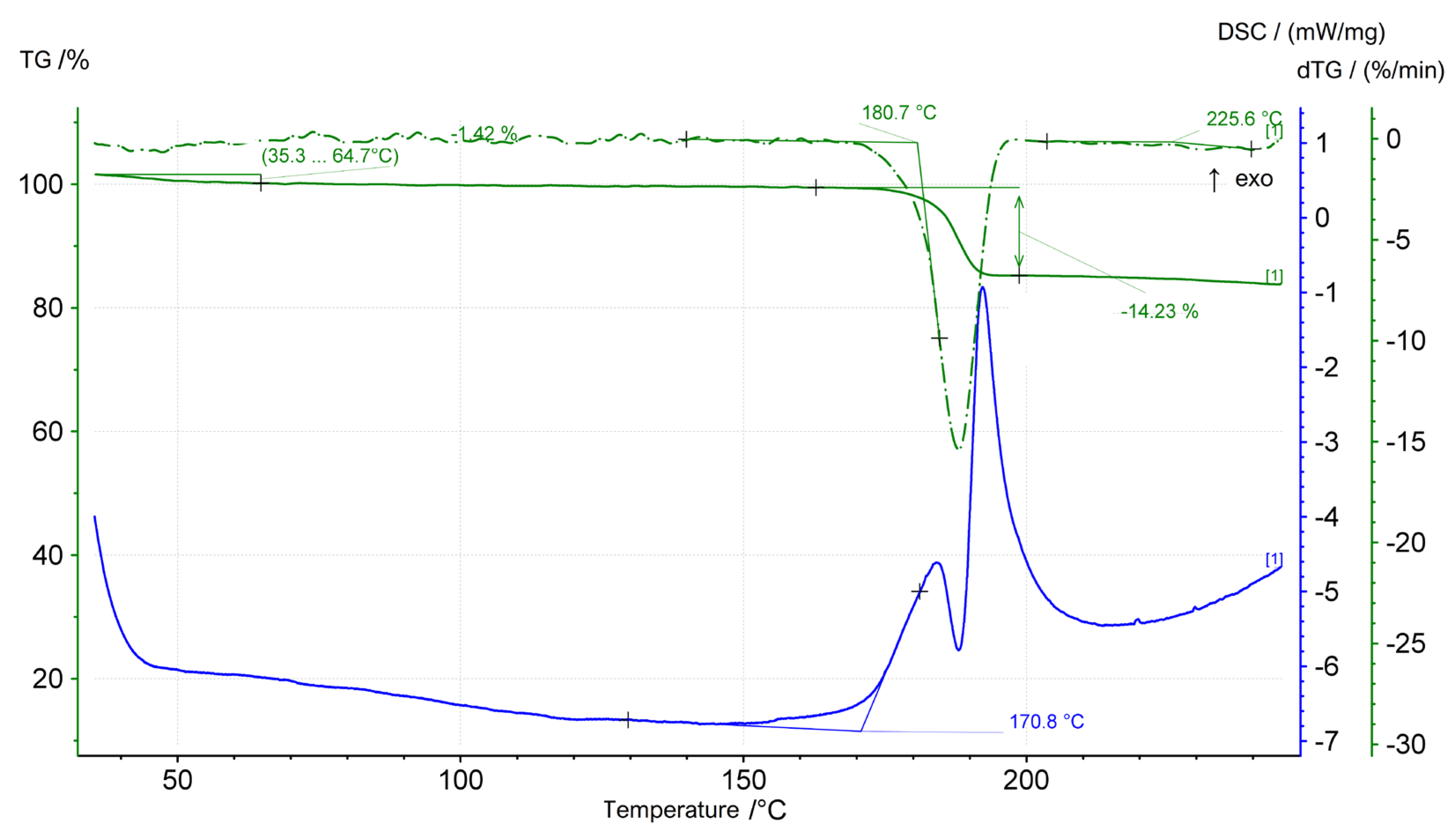

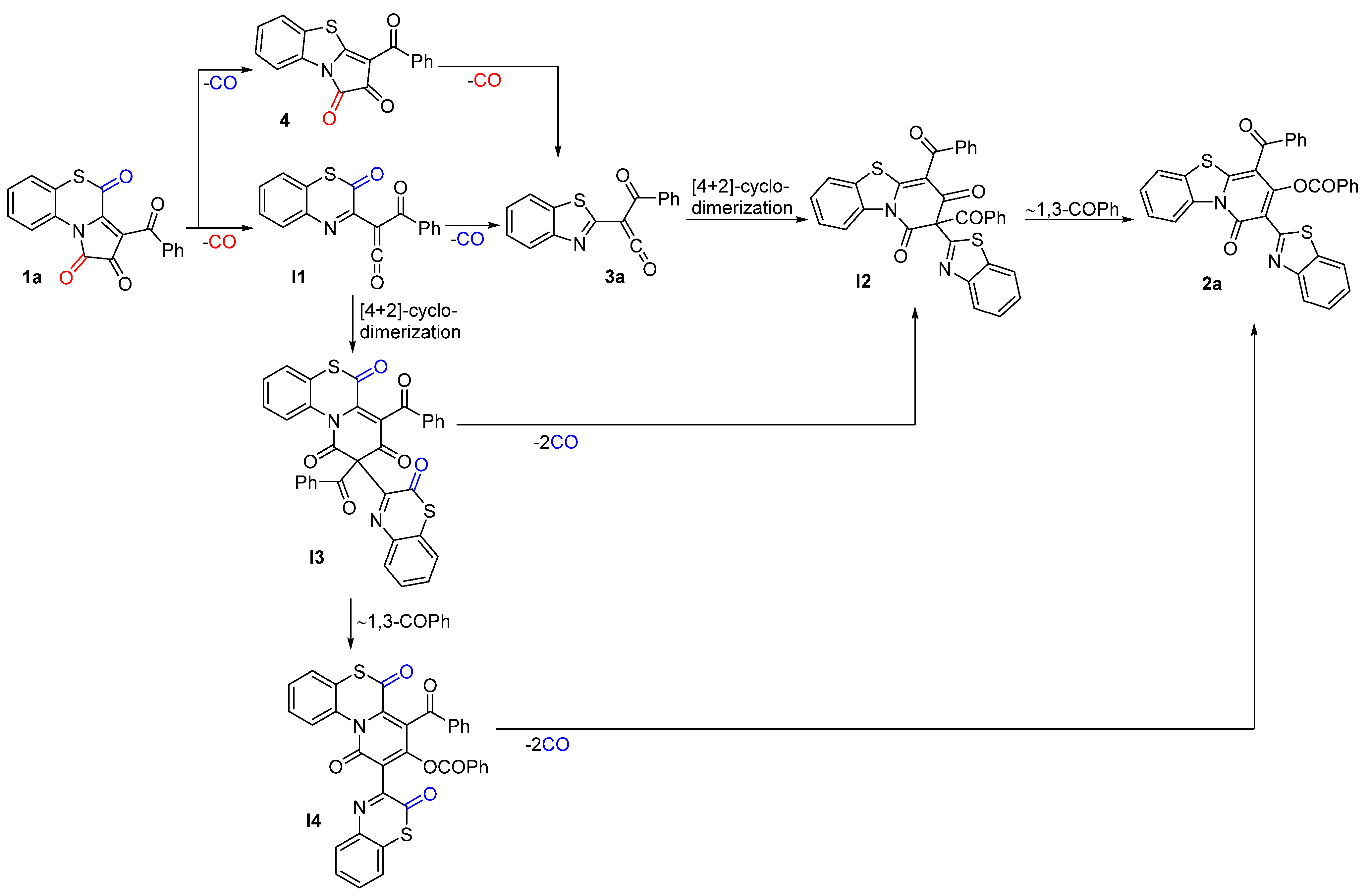

| Compound | Weight Loss Found (%) | Weight Loss Calcd (%) | Temp. of Decarbonylation (°C) | |
|---|---|---|---|---|
| Extrapolated Onset | Peak | |||
| 1a | 15 | 17 1 | 172 | 180 |
| 1b | 17 | 16 1 | 184 | 195 |
| 1c | 16 | 15 1 | 187 | 197 |
| 1d | 14 | 14 1 | 184 | 192 |
| 1e | 16 | 16 1 | 188 | 194 |
| 1f | 17 | 17 1 | 190 | 200 |
| 1g | 16 | 16 1 | 186 | 194 |
| 4 | 14 | 9 2 | 181 | 188 |
| Elementary Stage | ΔE, kcal/mol | ΔH, kcal/mol | ΔG, kcal/mol |
|---|---|---|---|
| 1a → 4 + C≡O | −22.6 | −29.2 | −70.4 |
| 4 → 3a + C≡O | 93.8 | 81.5 | 27.5 |
| 1a → I1 + C≡O | 83.2 | 72.2 | 21.5 |
| I1 → 3a + C≡O | −11.9 | −19.8 | −64.4 |
| 3a + 3a → I2 | −177.3 | −166.2 | −94.7 |
| I2 → 2a | −18.7 | −18.6 | −19.7 |
| I1 + I1 → I3 | −153.5 | −143.6 | −67.3 |
| I3 → I2 + C≡O + C≡O | −47.6 | −62.3 | −156.3 |
| I3 → I4 | −52.4 | −49.1 | −53.7 |
| I4 → 2a + C≡O + C≡O | −13.9 | −31.8 | −122.3 |
| Elementary Stage | ΔE≠, kcal/mol | ΔH≠, kcal/mol | ΔG≠, kcal/mol |
|---|---|---|---|
| 1a → 4 + C≡O (via TS_1ato4) | 21.4 | 20.6 | 23.9 |
| 4 → 3a + C≡O (via TS_4to3a) | 34.3 | 31.8 | 30.1 |
| 1a → I1 + C≡O (via TS_1atoI1) | 34.4 | 32.1 | 31.8 |
| I1 → 3a + C≡O (via TS_I1to3a) | 66.1 | 63.9 | 61.4 |
Disclaimer/Publisher’s Note: The statements, opinions and data contained in all publications are solely those of the individual author(s) and contributor(s) and not of MDPI and/or the editor(s). MDPI and/or the editor(s) disclaim responsibility for any injury to people or property resulting from any ideas, methods, instructions or products referred to in the content. |
© 2023 by the authors. Licensee MDPI, Basel, Switzerland. This article is an open access article distributed under the terms and conditions of the Creative Commons Attribution (CC BY) license (https://creativecommons.org/licenses/by/4.0/).
Share and Cite
Lystsova, E.A.; Novikov, A.S.; Dmitriev, M.V.; Maslivets, A.N.; Khramtsova, E.E. Approach to Pyrido[2,1-b][1,3]benzothiazol-1-ones via In Situ Generation of Acyl(1,3-benzothiazol-2-yl)ketenes by Thermolysis of Pyrrolo[2,1-c][1,4]benzothiazine-1,2,4-triones. Molecules 2023, 28, 5495. https://doi.org/10.3390/molecules28145495
Lystsova EA, Novikov AS, Dmitriev MV, Maslivets AN, Khramtsova EE. Approach to Pyrido[2,1-b][1,3]benzothiazol-1-ones via In Situ Generation of Acyl(1,3-benzothiazol-2-yl)ketenes by Thermolysis of Pyrrolo[2,1-c][1,4]benzothiazine-1,2,4-triones. Molecules. 2023; 28(14):5495. https://doi.org/10.3390/molecules28145495
Chicago/Turabian StyleLystsova, Ekaterina A., Alexander S. Novikov, Maksim V. Dmitriev, Andrey N. Maslivets, and Ekaterina E. Khramtsova. 2023. "Approach to Pyrido[2,1-b][1,3]benzothiazol-1-ones via In Situ Generation of Acyl(1,3-benzothiazol-2-yl)ketenes by Thermolysis of Pyrrolo[2,1-c][1,4]benzothiazine-1,2,4-triones" Molecules 28, no. 14: 5495. https://doi.org/10.3390/molecules28145495








